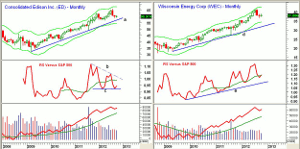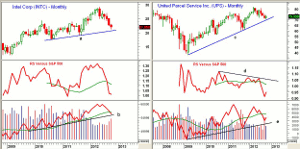Using monthly charts, MoneyShow's Tom Aspray identifies four stocks whose technical strength could make them good turnaround plays, and all have dividends of at least 3%.
The unprecedented weather-related closing of the major US stock, options, and futures markets may have added to markets' downward pressure. S&P 500 futures were down over 9 points prior to their early closing.
Given the storm projections, it would not be surprising to have the markets also closed on Tuesday, as public transportation in and out of New York is likely to be limited. Though the inability to act will make most traders and some investors nervous, it can provide an opportunity to review your portfolio holdings and review your plan.
In running my weekend Starc band analysis on S&P 500 stocks, the majority of the ten most oversold stocks had reported earnings last week, so the opportunities were limited. Therefore, I decided to look at the monthly analysis of the S&P 500 stocks, as we are already close to the end of the month.
At the top of the monthly most oversold list was Consolidated Edison (ED), which closed Friday at $59.89, was just 8.9% above the monthly Starc- band at $54.58.
As I reviewed the results, it was clear that many of the most oversold stocks had attractive yields, and had been dumped in anticipation of a change in the tax rate on dividends.
Though this is certainly a valid concern, often my monthly analysis can help identify stocks that are close to an important monthly low, look strong technically, and have the potential to rally 10% or more in the coming months. This growth potential makes them attractive for a portion of most portfolios.
The top four stocks are utilities. Southern Company (SO) was featured in a column early in the month titled 3 Ways to Invest Your Money Now. Since these stocks are well below the recent highs, their yields are now even more attractive. For example, Consolidated Edison (ED) at its summer high was yielding 3.66%, and now yields 4%.
I have selected the four oversold stocks that look the most interesting for new positions as we head into November.
Chart Analysis: Consolidated Edison (ED) is a $17.4 billion electric utility that serves the New York City area, and is likely to be impacted by Hurricane Sandy. ED made a high of $65.98 in August, and over the past two months has had a low of $59.01.
- The monthly uptrend (line a) is at $57.40, with key monthly support in the $57 area.
- The monthly relative performance will turn up this month, as support (line c) appears to have held.
- The RS analysis did form lower highs in August (line b), and a move above its WMA would be positive.
- The weekly RS line (not shown) has moved above its WMA.
- The on-balance volume (OBV) continues to act strong, as it made new highs in August, and it is well above its rising WMA.
- The weekly and daily OBV (not shown) are still below their WMAs, suggesting that the correction may not be over.
- There is initial resistance at $60.80 and then at $62.
Wisconsin Energy (WEC) is an $8.7 billion electric utility that peaked in August at $41.48, and had a low in September of $36.64.
- The monthly chart has further support at $35.38,which was the high in December 2011.
- The monthly relative performance or RS analysis did make new highs in August, and looks ready to close back above its WMA in October.
- The monthly OBV made convincing new highs last summer and still looks strong.
- The weekly OBV has improved, but is still below its WMA.
- WEC has initial resistance in the $38.93 area that was tested last week, with further levels around $39.80 to $40.
NEXT: Which of These Stocks Are Buys?
|pagebreak|Intel (INTC) has declined for the past four months, as concerns over dropping PC sales have hit it hard.
- INTC peaked at $29.27 in May and has dropped 27.5% from its highs. At its highs, it was yielding just over 3%, and now yields 4.1%.
- The monthly uptrend (line a) is now in the $20.70 area, with key support from the summer of 2011 at $19.16.
- The relative performance did make new highs early in the year, but dropped below its WMA in August.
- The OBV also confirmed the price highs, and as volume increased this month has now violated its WMA.
- The long-term uptrend in the OBV (line b) is still holding.
- Volume was strong late last week, but the weekly OBV (not shown) is still below its WMA.
- There is first strong weekly resistance at $22.60 and then in the $23.60 area.
United Parcel Service (UPS) released earnings last week, missing analyst revenue estimates, but still the stock bounced. The negative outlook from main competitor FedEx (FDX) in early September has also hurt UPS.
- UPS is now down 13% from its March high of $81.79.
- The monthly uptrend from late 2008 (line c) is at $70, with the recent low at $71.02.
- The relative performance dropped sharply at the end of July, but looks ready to turn up this month.
- The volume was high in September, but a positive close this month (above $71.57) will cause it to turn up.
- The weekly OBV turned up last week, but is still below its WMA.
- Tight ranges have been in place over the past month, with resistance first at $74.14 and then at $76.88.
What it Means: These four stocks are either close to or at monthly support. Therefore, many of the weak longs have likely already been sold.
Of course, the extent of the damage from the current storm will have an impact on the bottom line for Consolidated Edison (ED). If it sees another drop because of the storm, it should be a low-risk buying opportunity.
Wisconsin Energy (WEC) may have already bottomed, and investors should only buy near the recent lows. Intel (INTC) is also trying to stabilize, and I would expect its outlook to improve over the next several months, while United Parcel Service (UPS) has a positive seasonal tendency going into the holiday season.
How to Profit: For Consolidated Edison (ED), go 50% long at $58.42 and 50% at $57.72, with a stop at $56.54 (risk of approx. 2.4%).
For Wisconsin Energy (WEC), go 50% long at $37.14 and 50% at $36.52, with a stop at $35.74 (risk of approx. 3%).
For Intel (INTC), go 50% long at $21.34 and 50% at $20.88, with a stop at $20.18 (risk of approx. 4.4%).
For United Parcel Service (UPS), go 50% long at $72.04 and 50% at $71.12, with a stop at $69.29 (risk of approx. 3.2%).














